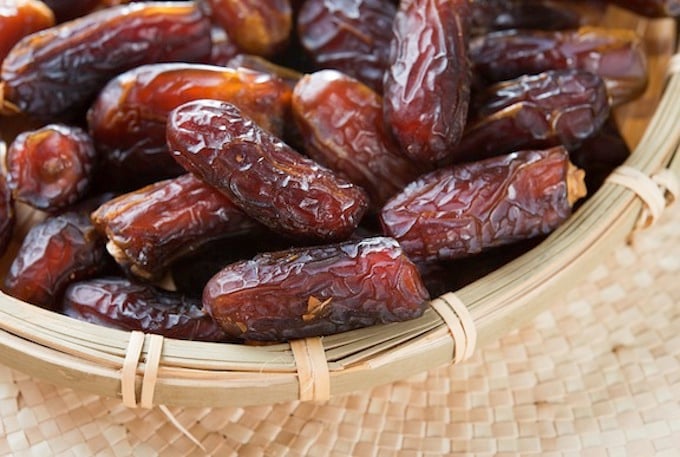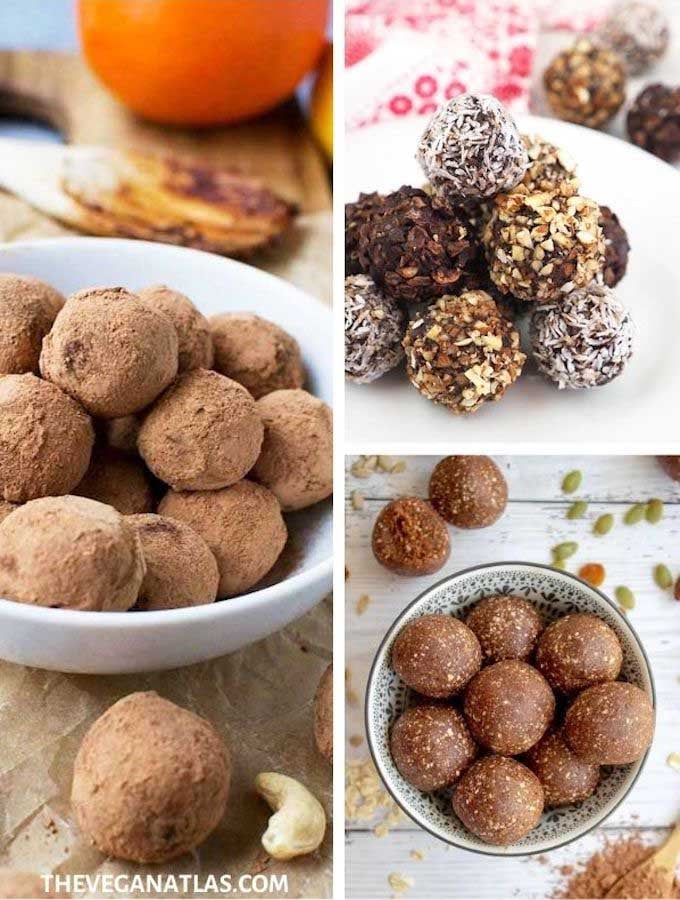Called “nature’s candy” by many and enjoyed by even more, dates are the sweetest fruits found in nature. What casual fans might not realize is there’s a vast array of different dates, far beyond the beloved Medjool. This guide to dried dates will demonstrate their versatility, with helpful tips and lots ways to use them.

The sugar content of dates is high enough for them to be transformed into dry and liquid sweeteners; they’re also perfectly suitable for enriching a wide variety of decadent treats as whole, raw fruits.
Most of the world enjoys them fresh, rather than dried. If you’re curious about these rubies of the desert, make it a date and learn more about the historically beloved fruits!
What Are Dates and Where Did They Come From?
Strong evidence suggests that dates may be the oldest cultivated fruit on Earth. Fossils show date palms from approximately 50 million years ago. Likely, they existed long before then, thriving even while dinosaurs roamed the planet. Their birthplace is spread across current-day Africa, Asia, and the Middle East.
Ancient cultures began cultivating them as food over 6,000 years ago, enjoying them much like fresh grapes, eating them as is, and using them to make wine. Once dried, it was discovered that dates were a highly portable source of nutrition for nomadic cultures, which kept well without further preservation.
Dates first arrived in the US, on the southern coast of California, when Spanish missionaries arrived in the 18th century. They struggled to thrive in the comparatively cool, dry climate, resulting in most of the palms dying off.
The majority of those that managed to survive were Medjool and Deglet Noor, which remain the most common two varieties found in mainstream grocery stores today.

Date varieties
Medjool dates are prized for their moist, soft, and almost creamy texture with superlative caramel-like sweetness and thin skin. They’re known as the “king of fruits” for good reason, commanding the steepest price accordingly.
Deglet Noor dates have a lower water content, resulting in a much chewier texture and sometimes papery skin.
Other varieties: Hundreds of different dates are still growing wild; other common species are the Khadrawy, Halawy, Barhi, Zahidi, and Thoory. Here are 14 of the most common date varieties.
There are others, but medjool and deglet noor are the ones most commonly found in Western markets. Though some may beg to differ, these dates may be used interchangeably in recipes.
How to buy and store dates
Most dates sold in the United States are already dried, or semi-dried, in the case of Medjool dates, which remain much softer than conventional dried fruit like raisins or cranberries.
The best varieties can be found at select farmers markets from late August through September. These fruits are so delicate that they must be picked by hand, which explains the steep price tag attached. Expect to pay $10 to 15 per pound for the cream of the crop.
High-quality dates can also be found in most well-stocked supermarkets and natural foods stores, particularly those that specialize in produce. They can often be found with the fresh fruits in 1-pound packages, and sometimes in the baking aisle or snack aisle as well.
Occasionally, dates will be available in the bulk section, but these are typically drier varieties meant for baking or cooking since they can be a bit sticky for that kind of storage. You can also find date pieces coated with oat flour in the bulk section; these bite-sized pieces are handy, since they can easily be tossed into cookies or quick breads.
Although they are classified as dried or semi-dried fruits, you should store dates in the fridge to prolong freshness. Make sure they’re sealed in an airtight container, and they can keep for up to 6 months in this way.

Prep tips
Before contemplating eating or cooking with dates, make sure you remove the pits first! They can sometimes cling tenaciously to the sticky flesh, so you may need to use a sharp paring knife to cut out the full seed. Most of the time, though, the seeds pop out with a gentle prodding from your clean fingers.
To chop dates into smaller pieces for use in recipes, you may want to lightly grease your knife to prevent the pieces from sticking, allowing for cleaner, more consistent cuts.
Before adding cut dates into baked goods, toss them in flour to keep the pieces separated in the batter. If working with drier varieties of dates, it’s a good idea to soak them briefly in warm water to rehydrate them, creating a softer, moister bite.
 See also: A Guide to Date Sugar & Date Syrup (Silan)
See also: A Guide to Date Sugar & Date Syrup (Silan)
Nutrition notes
Dates are an incredibly nutrient-dense food, making them ideal snacks for long trips. They’re also very high in calories, primarily in the form of carbohydrates. In contrast to most sources of sweetness, though, they have a comparably low glycemic index, making them a great choice for anyone seeking a way to satisfy their sweet tooth without spiking their blood sugar.
Dates are a good source of many vitamins and minerals, especially pantothenic acid, vitamin B6, magnesium, manganese, and potassium. They’re naturally fat-free and contain a moderate amount of fiber, making them much more satisfying than other candies or treats. Here’s the full nutrition profile of dates.

Serving suggestions and ways to use dried dates
Dates are amazingly versatile! Be sure to scroll down past this section for two amazing round-ups highlighting date recipes.
Date paste and date syrup (silan): You can often buy these readymade, but they’re easy to make at home —especially date paste. They both require only dates and water! Here’s a recipe for date paste, and one for date syrup.
Smoothies: Date shakes were popularized by date growers in Palm Springs, but you can also use dates to sweeten any fruit smoothie. Try a Morning Date Smoothie for a decadent breakfast or wholesome dessert.
Raw caramel sauce: Perfect for drizzling over ice cream, fresh fruit, and so much more, it only takes two ingredients to make Date Caramel Sauce without any refined sugars.
A quick bread fruit: Chopped dates add a delectable sweetness to quick breads. In this classic Vegan Banana Bread, recipe, 1/2 cup of chopped dates are an optional ingredient; try it!
Candies: Take advantage of the naturally fudgy texture of Medjool dates and simply add chocolate. That’s all it takes to create rich 2-Ingredient Chocolate Fudge that you can sink your teeth into.
Stuffed dates: Once pitted, dates are perfectly shaped to accommodate all sorts of fillings to make a perfect, bite-sized snack. It can be something as simple as a smear of almond butter or chopped walnuts, or you could make Caramel Chewies that taste like full-fledged candy bars. For a savory twist, try Vegan Bacon-Wrapped Dates that are stuffed with dairy-free cream cheese.
Protein Bars and Energy Balls: Store-bought protein bars are often expensive and packed with sugar. Homemade Protein Bars are easy to customize according to your personal preferences with endless flavor variations and better ingredients overall. Energy Balls
Granola: While you could always add chopped dates into your favorite granola formula after baking for extra bites of sweetness, they’re also fantastic when used as a sticky binder to make more substantial oat clusters, as is the case in this recipe for Golden State Granola.
Salads: When fresh berries are out of season, consider using chopped dates to add a subtle, contrasting note of sweetness in your leafy green salads. Salad with Dates, Apples, Walnuts & Maple Balsamic Dressing is a great example.
Contributed by Hannah Kaminsky: Hannah has developed an international following for her delicious recipes and mouthwatering food photography at the award-winning blog BitterSweet. Passionate about big flavors and simple techniques, she’s the author of Vegan Desserts, Vegan à la Mode, Easy as Vegan Pie, Real Food, Really Fast, Sweet Vegan Treats, The Student Vegan Cookbook, Super Vegan Scoops, and The Everyday Vegan Cheat Sheet Pan. Visit Hannah at BittersweetBlog.com.
If you like dates, you might also enjoy …
 15 Delectable Vegan Date Energy Balls and Truffles
15 Delectable Vegan Date Energy Balls and Truffles
See more of this site’s Good Food Guides.


I was looking for instructions to use dried dates. I did not find any information or what and how to accomplish this. Add water?? cook? Help
I have a recipe that calls for date sugar, which I thought I had (but hubby’s been adding it to his morning oatmeal and left the empty container in the pantry!) I do have date syrup, but don’t know what the equivalency is. Any guidance?
Ladawn, I’m not sure you can swap one for the other in every kind of recipe — baking is pretty specific in terms of how much liquid can be added before it makes a batter too wet, for example. I think it may be safer to swap in a dry sugar like Sucanat or Florida Crystals, in this case. But if it’s a smoothie or some such, you can just add your date syrup to taste. I hope that helps!